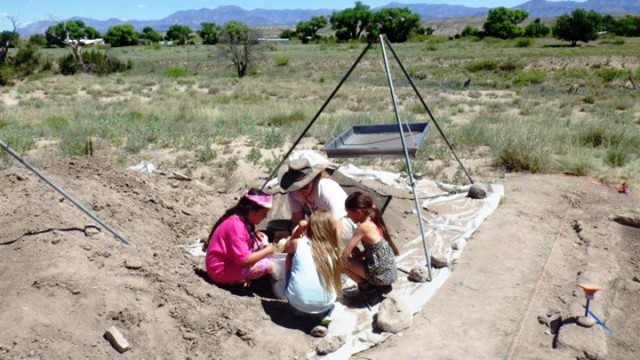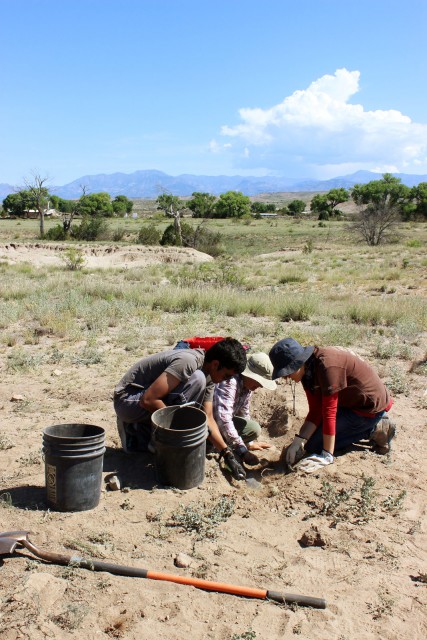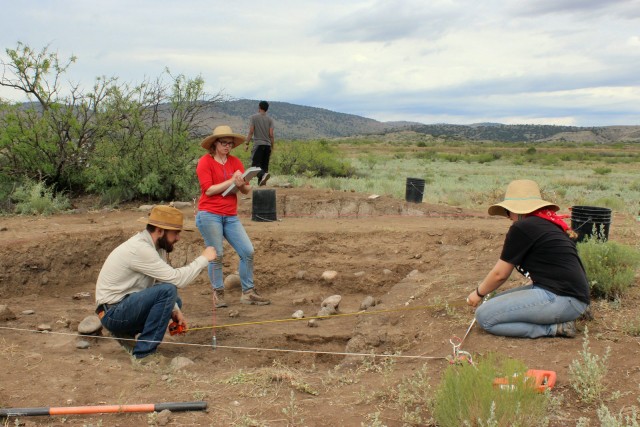- Home
- >
- Preservation Archaeology Blog
- >
- What We’re Doing at the 2015 Field School

As you can tell if you’re following Archaeology Southwest on Facebook, our 2015 field season is off and running! This year, as in the past, students are rotating through experiences in excavation, archaeological survey, field laboratory analysis, and experimental archaeology.
Our twelve undergraduates and two graduate students have come together from colleges and universities all over the country to spend six weeks learning archaeological field techniques in the context of Preservation Archaeology. Their varied experiences and assignments throughout the field season will combine research, preservation, and public outreach. Students are already recovering artifacts in the field and classifying them in the lab; as the course progresses they will help analyze the data they collected, and interpret the results both for professional audiences and for the public in written summaries, blog posts, and local public events.

This field season will be our last excavating at the Dinwiddie site. Like last year, we are focusing our excavations on partially disturbed deposits and areas of the site that are undergoing or are at risk from erosion. Last year’s work showed substantial differences between groups of adobe rooms in different sections of the site. A group of rooms located at the edge of a modern roadbed showed lots of remodeling episodes, suggesting this area was used for a long period. An excavated room in another area had very little remodeling, but had an intriguing T-shaped doorway (unusual for this area and time period) and more El Paso Polychrome pottery, a type linked with areas to the southeast. This year’s excavation work is focused on assessing whether these differences extend to the third block of adobe rooms on the site. We are also doing limited testing in a variety of locations to get a better understanding of the site layout and architectural variability.

Our archaeological survey work this year takes place on private land, where landowners have generously granted us access to their properties in order to record previously undocumented sites. This work is important for expanding our understanding of how ancient people used the landscape, including the locations where they chose to settle during different time periods as social and environmental conditions changed. It’s also an important component of students’ training, as many job opportunities in archaeology are focused on survey.
Experimental archaeology is a somewhat unusual field school component, but as our students’ blog posts show, it is very useful in improving our understanding of the artifacts we’re finding in the field. Learning to flintknap, make pottery, and build an adobe structure gives us insights into factors like why our excavated walls crack in the patterns they do, and how to distinguish flaked stone from naturally broken rocks. This experience also helps with artifact analysis in our field lab.
Experimental archaeology is also an important component of our public outreach programs. Giving people an opportunity to use replicas of ancient tools helps them imagine how people used similar items centuries ago. We hope this fosters a greater appreciation for these traces of the past, an important thing in an area where archaeological sites are everywhere on the landscape. Our excavation site’s location near a road also gives us opportunities to chat with passersby about what we’re finding.
Our students are already hard at work on their final projects for the course: presentations and displays for our Archaeology Fair at the Gila Library at the end of the month. Each student contributes to the field notes and excavation unit summaries that form a permanent record of our work for the professional archaeological community. Their blog posts and Archaeology Fair projects provide an opportunity to share what they’ve learned in a less formal context that’s accessible to a wider audience. Sharing what we learn with children and adults in the Upper Gila area helps spread our preservation message, and gives us a way of giving something back to the local community that hosts us each summer in this beautiful and archaeologically fascinating place.
After seven years of Archaeology Southwest’s work in the Upper Gila, archaeologists have become somewhat akin to a migratory species here. I look forward to coming here each year, and I hope the people we’ve gotten to know over the years enjoy seeing us return.

Photos:
Explore the News
-
Join Today
Keep up with the latest discoveries in southwestern archaeology. Join today, and receive Archaeology Southwest Magazine, among other member benefits.